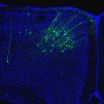(Press-News.org) By manipulating neural circuits in the brain of mice, scientists have altered the emotional associations of specific memories. The research, led by Howard Hughes Medical Institute investigator Susumu Tonegawa at the Massachusetts Institute of Technology (MIT), reveals that the connections between the part of the brain that stores contextual information about an experience and the part of the brain that stores the emotional memory of that experience are malleable.
Altering those connections can transform a negative memory into a positive one, Tonegawa and his MIT colleagues report in the August 28, 2014, issue of the journal Nature.
"There is some evidence from pyschotherapy that positive memory can suppress memories of negative experience," Tonegawa says, referring to treatments that reduce clinical depression by helping patients recall positive memories. "We have shown how the emotional valence of memories can be switched on the cellular level."
The episodes and events that we experience become intimately associated with emotion as they are stored as memories in the brain. Recalling a favorite vacation may summon pleasure for years to come, whereas the fear that accompanies a memory of assault might cause a victim to never return to the scene of the crime. Tonegawa explains that the contextual information about these events – where and when they happened – is recorded in the brain's hippocampus, whereas the emotional component of the memory is stored separately, in a brain region called the amygdala. "The amygdala can store information with either a positive or negative valence, and associate it with a memory," Tonegawa explains.
Last year, Tonegawa and his colleagues reported that by artificially activating the small set of cells that stored a specific memory in a mouse, they could create a new, false memory. In that study, the team made the cells that stored a memory of a safe environment sensitive to light, so that they could be manipulated by the researchers. Switching on those cells while subjecting the animal to a mild shock in a new environment caused the mouse to fear the original environment, even though it had had no unpleasant experiences there.
In those experiments, the scientists had caused the mice to associate a neutral setting with fear. Now Tonegawa and his colleagues wanted to see if he could alter a memory that was already associated with emotion. Once an animal had developed fear of a place, could the memory of that place be made pleasurable instead?
To find out, the scientists began by placing male mice in a chamber that delivered a mild shock. As the mouse formed of memory of this dangerous place, Tonegawa's team used a method it had previously developed to introduce a light-sensitive protein into the cells that stored the information. By linking the production of the light-sensitive protein to the activation of a gene that is switched on as memories are encoded, they targeted light-sensitivity to the cells that stored the newly formed memory.
The mice were removed from the chamber and a few days later, the scientists artificially reactivated the memory by shining a light into the cells holding the memory of the original place. The animals responded by stopping their explorations and freezing in place, indicating they were afraid.
Now the scientists wanted to see if they could overwrite the fear and give the mice positive associations to the chamber, despite their negative experience there. So they placed the mice in a new environment, where instead of a shock they had the opportunity to interact with female mice. As they did so, the researchers activated their fear memory-storing neurons with light. The scientists activated only one subset of memory-storing neurons at a time – either those in the context-storing hippocampus or those in the emotion-storing amygdala. They then tested the emotional association of the memory of the original chamber by giving mice the opportunity to move away from an environment in which the memory was artificially triggered.
Reactivating the amygdala component of the memory while the male mice had the pleasurable experience of interacting with females failed to change the fear response driven by those amygdala neurons. Consequently, mice retained their fear. When the researchers reactivated the memory-storing cells in the hippocampus while the mice interacted with females, however, the memory cells in the hippocampus acquired a new emotional association. Now the mice sought out environments that triggered the memory.
"So the animal acquired a pleasure memory," Tonegawa says. "But what happened to the original fear memory? Is it still there or is it gone?" When they put the animals back in the original chamber, where they had experienced the unpleasant shock, the animals showed less fear and more exploratory and reward-seeking behaviors. "The original fear memory is significantly changed," Tonegawa concludes.
The researchers had similar results in experiments where they switched the emotion of a memory in the opposite direction – allowing mice to first develop a pleasurable memory of the chamber, then artificially activating the memory-storing cells in the hippocampus while the animals experienced a shock. In those mice, the pleasurable response linked to the hippocampal memory cells was replaced with a fear response.
The experiments indicate that the cells that store the contextual components of a memory form impermanent or malleable connections to the emotional components of that memory. Tonegawa explains that while a single set of neurons in the hippocampus stores the contextual information about a memory, there are two distinct sets of neurons in the amygdala to which they can connect: one set responsible for positive memory, the other responsible for negative memory. Circuits connect the hippocampal cells to each of the two populations of cells in the amygdala. "There is a competition between these circuits that dictates the overall emotional value and [positive or negative] direction of a memory," Tonegawa says.
In an accompanying News & Views article in Nature, Tomonori Takeuchi and Richard G.M. Morris of the University of Edinburgh, state, "What is so intriguing about this study is that the memory representations associated with a place are dissected into their network components and, rather than re-exposing the animals to the training situation to achieve a change, light is used to selectively reactivate the representation of the 'where' component of a memory and then change its 'what' association."
Tonegawa emphasizes that their success in switching the emotion of a memory in mice does not translate to an immediate therapy for patients. There is no existing technology to manipulate neurons in people as they did in their mouse experiments. However, he says, the findings suggest that neural circuits connecting the hippocampus and the amygdala might be targeted for the development of new drugs to treat mental illness.
INFORMATION:
Researchers change the emotional association of memories
2014-08-27
ELSE PRESS RELEASES FROM THIS DATE:
Witnessing the early growth of a giant
2014-08-27
Elliptical galaxies are large, gas-poor gatherings of older stars and are one of the main types of galaxy along with their spiral and lenticular relatives. Galaxy formation theories suggest that giant elliptical galaxies form from the inside out, with a large core marking the very first stages of formation.
However, evidence of this early construction phase has eluded astronomers — until now.
Astronomers have now spotted a compact galactic core known as GOODS-N-774, and nicknamed Sparky [1]. It is seen as it appeared eleven billion years ago, just three billion years ...
Stop and listen: Study shows how movement affects hearing
2014-08-27
DURHAM, N.C. -- When we want to listen carefully to someone, the first thing we do is stop talking. The second thing we do is stop moving altogether. This strategy helps us hear better by preventing unwanted sounds generated by our own movements.
This interplay between movement and hearing also has a counterpart deep in the brain. Indeed, indirect evidence has long suggested that the brain's motor cortex, which controls movement, somehow influences the auditory cortex, which gives rise to our conscious perception of sound.
A new Duke study, appearing online August 27 ...
NASA sees massive Marie close enough to affect southern California coast
2014-08-27
Two NASA satellites captured visible and infrared pictures that show the massive size of Hurricane Marie. Marie is so large that it is bringing rough surf to the southern coast of California while almost nine hundred miles west of Baja California.
On August 26 at 19:05 UTC (3:05 p.m. EDT) NASA's Terra satellite captured a visible image of Hurricane Marie drawing in the small remnants of Karina. Marie is over 400 miles in diameter, about the distance from Washington, D.C. to Boston, Massachusetts. Hurricane force winds extend outward up to 60 miles (95 km) from the center ...
Scripps Research Institute scientists link alcohol-dependence gene to neurotransmitter
2014-08-27
LA JOLLA, CA – August 27, 2014 – Scientists at The Scripps Research Institute (TSRI) have solved the mystery of why a specific signaling pathway can be associated with alcohol dependence.
This signaling pathway is regulated by a gene, called neurofibromatosis type 1 (Nf1), which TSRI scientists found is linked with excessive drinking in mice. The new research shows Nf1 regulates gamma-aminobutyric acid (GABA), a neurotransmitter that lowers anxiety and increases feelings of relaxation.
"This novel and seminal study provides insights into the cellular mechanisms of ...
Expression of privilege in vaccine refusal
2014-08-27
DENVER (August 27, 2014) – Not all students returning to school this month will be up to date on their vaccinations. A new study conducted by Jennifer Reich, a researcher at the University of Colorado Denver, shows that the reasons why children may not be fully vaccinated depends on the class privilege of their mothers.
According to the National Network for Immunization Information, three children per 1000 in the U.S. have never received any vaccines, with almost half of all children receiving vaccines later than recommended. The number of unvaccinated children has led ...
Dosage of HIV drug may be ineffective for half of African-Americans
2014-08-27
Many African-Americans may not be getting effective doses of the HIV drug maraviroc, a new study from Johns Hopkins suggests. The initial dosing studies, completed before the drug was licensed in 2007, included mostly European-Americans, who generally lack a protein that is key to removing maraviroc from the body. The current study shows that people with maximum levels of the protein — including nearly half of African-Americans — end up with less maraviroc in their bodies compared to those who lack the protein even when given the same dose. A simple genetic test for the ...
Scientists plug into a learning brain
2014-08-27
Learning is easier when it only requires nerve cells to rearrange existing patterns of activity than when the nerve cells have to generate new patterns, a study of monkeys has found. The scientists explored the brain's capacity to learn through recordings of electrical activity of brain cell networks. The study was partly funded by the National Institutes of Health.
"We looked into the brain and may have seen why it's so hard to think outside the box," said Aaron Batista, Ph.D., an assistant professor at the University of Pittsburgh and a senior author of the study published ...
Pitt and Carnegie Mellon engineers discover why learning can be difficult
2014-08-27
PITTSBURGH—Learning a new skill is easier when it is related to ability that we already possess. For example, a trained pianist might learn a new melody more easily than learning how to hit a tennis serve.
Neural engineers from the Center for the Neural Basis of Cognition (CNBC)—a joint program between the University of Pittsburgh and Carnegie Mellon University—have discovered a fundamental constraint in the brain that may explain why this happens. Published as the cover story in the Aug. 28, 2014, issue of Nature, they found for the first time that there are constraints ...
Kessler Foundation scientists study impact of cultural diversity in brain injury research
2014-08-27
West Orange, NJ. August 27, 2014. Kessler Foundation scientists examined the implications for cultural diversity and cultural competence in brain injury research and rehabilitation. The article by Anthony Lequerica, PhD, and Denise Krch, PhD: Issues of cultural diversity in acquired brain injury (ABI) rehabilitation (doi:10.3233/NRE-141079) was published by Neurorehabilitation. Drs. Lequerica and Krch are research scientists in Traumatic Brain Injury (TBI) Research at Kessler Foundation and co-investigators for the Northern New Jersey TBI Model System.
Cultural sensitivity ...
New smartphone app can detect newborn jaundice in minutes
2014-08-27
Newborn jaundice: It's one of the last things a parent wants to deal with, but it's unfortunately a common condition in babies less than a week old.
Skin that turns yellow can be a sure sign that a newborn is jaundiced and isn't adequately eliminating the chemical bilirubin. But that discoloration is sometimes hard to see, and severe jaundice left untreated can harm a baby.
University of Washington engineers and physicians have developed a smartphone application that checks for jaundice in newborns and can deliver results to parents and pediatricians within minutes. ...






